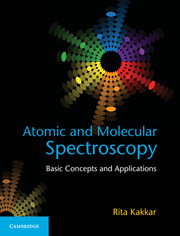Book contents
- Frontmatter
- Dedication
- Contents
- List of Figures
- List of Tables
- Preface
- Acknowledgements
- List of Abbreviations
- 1 Fundamentals of Spectroscopy
- 2 Theoretical Principles
- 3 Atomic Spectroscopy
- 4 Pure Rotational Spectroscopy
- 5 Vibrational Spectroscopy of Diatomics
- 6 Vibrational Spectroscopy of Polyatomic Molecules
- 7 The Raman Effect
- 8 Electronic Spectroscopy of Diatomic Molecules
- 9 Electronic Spectroscopy of Polyatomic Molecules
- Appendix 1 THE SPECTRUM OF THE NON-RIGID ROTATOR
- Appendix 2 CHARACTER TABLES OF SOME IMPORTANT SYMMETRY GROUPS
- References
- Index
2 - Theoretical Principles
Published online by Cambridge University Press: 05 June 2015
- Frontmatter
- Dedication
- Contents
- List of Figures
- List of Tables
- Preface
- Acknowledgements
- List of Abbreviations
- 1 Fundamentals of Spectroscopy
- 2 Theoretical Principles
- 3 Atomic Spectroscopy
- 4 Pure Rotational Spectroscopy
- 5 Vibrational Spectroscopy of Diatomics
- 6 Vibrational Spectroscopy of Polyatomic Molecules
- 7 The Raman Effect
- 8 Electronic Spectroscopy of Diatomic Molecules
- 9 Electronic Spectroscopy of Polyatomic Molecules
- Appendix 1 THE SPECTRUM OF THE NON-RIGID ROTATOR
- Appendix 2 CHARACTER TABLES OF SOME IMPORTANT SYMMETRY GROUPS
- References
- Index
Summary
Dad I understand that light is emitted when an atom decays from an excited state to a lower energy state.
Feynman That's right.
Dad And light consists of particles called photons.
Feynman Yes.
Dad So the photon ‘particle’ must be inside the atom when it is in the excited state.
Feynman Well no.
Dad Well how do you explain that the photon comes out of the atom when it was not there in the first place.
Feynman (Physics Teacher 1969) I'm sorry. I don't know I can't explain it to you.
INTRODUCTION
As was stated in Chapter 1, spectroscopy is a study of the interaction of matter with radiation. In order to understand their mutual interaction, we must therefore characterize both radiation and matter. The starting point is quantum mechanics, because the origin of quantum mechanics was based on unexplained phenomena related to both the nature of electromagnetic radiation and that of matter. In fact, quantum mechanics owes its birth to some puzzling results of spectral and other experiments. We may say that “spectroscopy is quantum mechanics in action.” We therefore begin our study of quantum mechanics with a recapitulation of its postulates. An understanding of the postulates is also essential for our development of the time-dependent perturbation theory and also forms the basis for the connection between theory and experiment. Indeed, spectroscopy is the experimental verification of the laws of quantum mechanics.
Quantum mechanics is based on a few postulates (from the Latin postulatum), meaning a truth that does not need any further proof, because it is obvious by itself, and its success lies in the fact that no experiment till date has proved it wrong. There is no agreement of how many axioms one needs to describe the machinery of quantum mechanics; however, the six given below is an acceptable number.
Information
- Type
- Chapter
- Information
- Atomic and Molecular SpectroscopyBasic Concepts and Applications, pp. 51 - 78Publisher: Cambridge University PressPrint publication year: 2015
